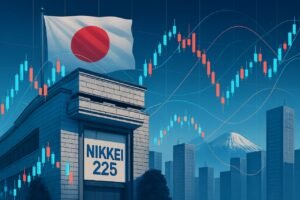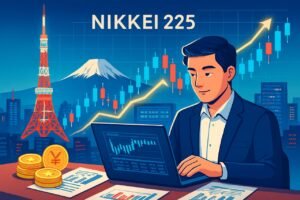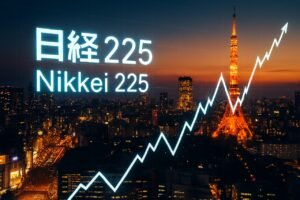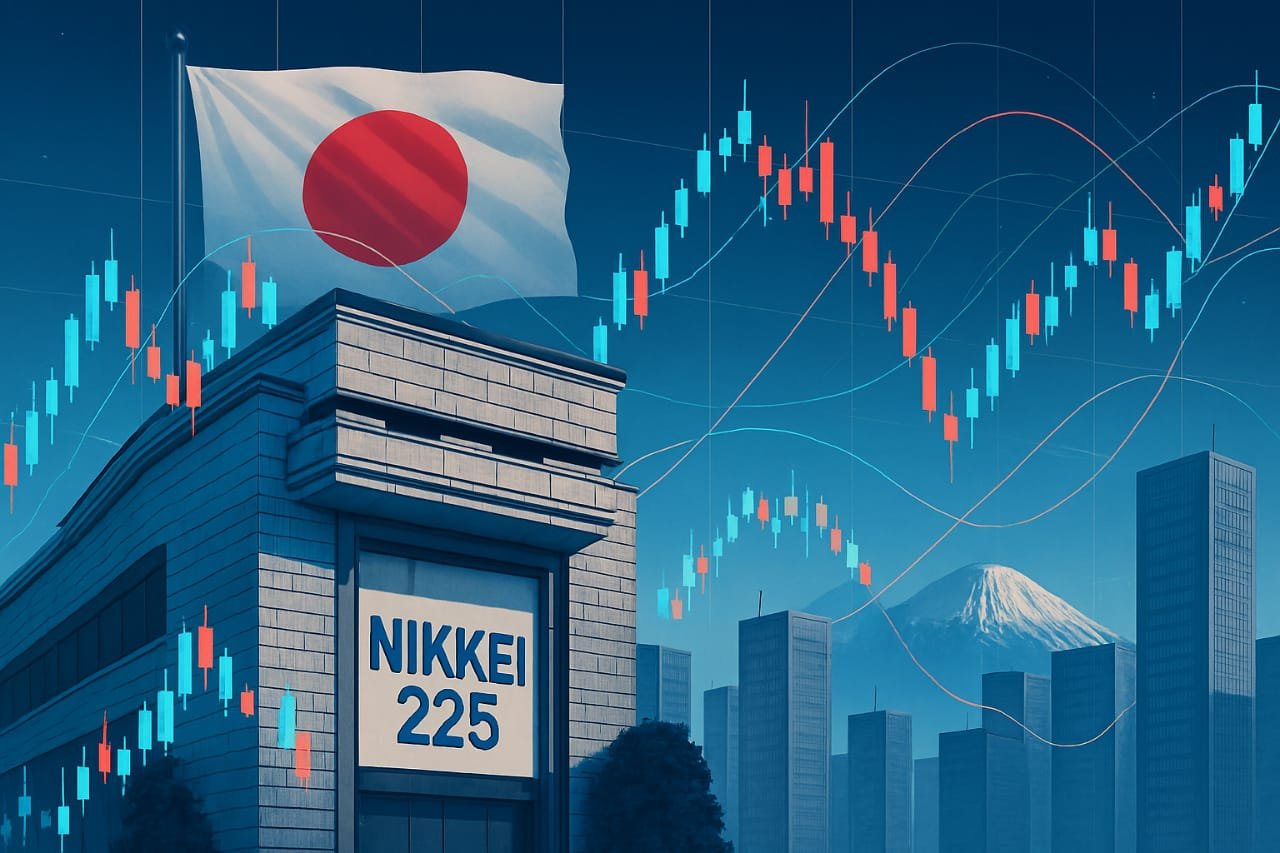Nikkei 225: Japan’s Market Giant Explained with Key Insights & Global Impact
When people think about major stock indices, the Dow Jones, S&P 500, or Nasdaq often steal the spotlight. But what about the Nikkei 225—the heartbeat of Japan’s economy and one of Asia’s most closely watched indices?

Whether you’re a seasoned investor, a financial analyst, or simply curious about global markets, understanding the Nikkei 225 is crucial for grasping the larger economic narrative of Asia.
In this post, we’ll explore what makes the Nikkei 225 unique, how it compares to other global indices, and why it matters more today than ever before.
🔍 What Is the Nikkei 225?
The Nikkei 225, also known as the Nikkei Stock Average, is Japan’s premier stock market index, representing 225 of the most actively traded companies on the Tokyo Stock Exchange (TSE).
Key Highlights:
-
Launched in: 1950
-
Managed by: Nihon Keizai Shimbun (Japan’s largest business newspaper)
-
Companies Included: Toyota, Sony, SoftBank, Nintendo, Mitsubishi, and more
-
Weighting Method: Price-weighted (like the Dow Jones), meaning higher-priced stocks have a bigger impact on the index.
This differs from market capitalization-weighted indices like the S&P 500, where larger companies by market value influence index movements more.
🇯🇵 Why the Nikkei 225 Matters Globally
Japan has the third-largest economy in the world by nominal GDP, and many of its companies play pivotal roles in global industries—from electronics to automobiles.
Here’s why investors and analysts globally pay close attention to the Nikkei 225:
-
Economic Indicator: It reflects the health of Japan’s economy and indirectly the wider Asia-Pacific region.
-
Tech & Manufacturing Exposure: Many constituent companies are global leaders in innovation.
-
Currency Sensitivity: It often correlates with movements in the Japanese Yen (JPY), impacting forex markets.
-
Policy Impact: Japan’s central bank (BoJ) is known for aggressive monetary policies that influence Nikkei movements.
📊 Nikkei 225 vs. Global Indices
Let’s take a side-by-side look at how the Nikkei Index stacks up against its global peers:
| Feature | Nikkei 225 | S&P 500 | Dow Jones Industrial Average | FTSE 100 |
|---|---|---|---|---|
| Market | Tokyo Stock Exchange | NYSE/Nasdaq | NYSE | London Stock Exchange |
| No. of Companies | 225 | 500 | 30 | 100 |
| Weighting Method | Price-weighted | Market Cap-weighted | Price-weighted | Market Cap-weighted |
| Sector Representation | Broad | Broad | Industrial-heavy | Blue-chip-focused |
| Currency Exposure | Japanese Yen | US Dollar | US Dollar | British Pound |
| Notable Stocks | Toyota, Sony, Fast Retailing | Apple, Microsoft, Google | Boeing, IBM, Coca-Cola | HSBC, BP, Unilever |
➡️ See the full list of Nikkei 225 constituents
📈 Performance Trends: How Has the Nikkei 225 Performed?
Historically, the Nikkei Index hit its peak in 1989, closing above 38,900 during Japan’s asset price bubble. After a long slump through the 1990s and 2000s, the index began recovering in the 2010s.
Recent Performance Snapshot (2020–2025):
| Year | Closing Price (Approx) | Major Events |
|---|---|---|
| 2020 | 27,444 | COVID-19 Pandemic Recovery |
| 2021 | 28,791 | Supply Chain Pressures |
| 2022 | 26,094 | Global Inflation Concerns |
| 2023 | 31,300 | BoJ Policy Shift |
| 2024 | 34,250 | Tech Rally & Weak Yen |
| 2025* | 36,500+ (as of Aug) | Export Boom, AI Surge |
📌 Stay updated via Nikkei Asia
💡 Unique Aspects of the Nikkei 225
1. Price-Weighted Anomaly
Unlike most modern indices, the Nikkei is price-weighted, which can skew its performance due to a handful of high-priced stocks—such as Fast Retailing (Uniqlo’s parent)—dominating index movements.
Investor Tip: Don’t judge the Japanese market solely based on the Nikkei’s movement. Consider complementary indices like TOPIX (Tokyo Stock Price Index), which is market cap-weighted.
2. High Export Exposure
Many Nikkei-listed firms derive a significant chunk of their revenues from overseas markets. This makes the index sensitive to global demand, currency rates, and geopolitical tensions.
3. Government and Central Bank Influence
The Bank of Japan (BoJ) has been an active participant in equity markets, even purchasing ETFs linked to the Nikkei to stimulate the economy—a rare policy among central banks.
📍 Investing in the Nikkei 225: How to Get Started
You don’t need to live in Japan to invest in the Nikkei Index. Here are a few easy ways:

🔹 1. Nikkei 225 ETFs
-
iShares Nikkei 225 ETF (Tokyo: 1329)
-
Nomura Nikkei 225 ETF (Tokyo: 1321)
-
MAXIS Nikkei 225 ETF
Also available on global brokerages via:
-
US-listed ETFs (e.g., iShares Japan (EWJ))
-
ADR Listings of individual Nikkei stocks (e.g., Toyota, Sony)
🔹 2. Mutual Funds & Index Funds
Several global fund houses offer Japanese equity exposure through mutual funds.
🔹 3. CFDs & Derivatives
Traders looking for leverage or short-term exposure can use contracts-for-difference (CFDs) or Nikkei futures on platforms like IG, Saxo, or Bitget.
💬 Personal Perspective: Why I Track the Nikkei 225
As someone deeply involved in global finance content, the Nikkei Index has long intrigued me—not just because it reflects Japanese corporate strength but also because it provides a unique lens into Asia’s evolving economic narrative.
Here’s what I’ve learned from tracking the Nikkei:
-
Currency trends, like a weakening yen, can benefit Japanese exporters—and boost the Nikkei.
-
Central bank policies can have long-term market impacts when combined with fiscal stimulus.
-
Innovation is thriving in Japan—robotics, automotive tech, and gaming are key sectors quietly dominating globally.
The Nikkei isn’t just a barometer for Japan—it’s a proxy for the entire Asia-Pacific tech and industrial ecosystem.
🔗 Related Topics Worth Exploring
✅ Conclusion: Why the Nikkei 225 Deserves Your Attention
In a globalized economy, understanding regional market dynamics like those of the Nikkei Index is more than just good investing—it’s strategic foresight.
The Nikkei serves as:
-
A window into Asia’s economic pulse
-
A gateway for investors seeking diversification
-
A barometer for global trade and innovation trends

Whether you’re managing a portfolio, planning global exposure, or simply learning about market indices, don’t overlook the Nikkei Index. It offers lessons in resilience, innovation, and the interconnectedness of modern markets.
📢 What’s Next?
👉 Got questions about the Nikkei Index or Japanese market investing? Drop a comment below!
📩 Subscribe to our newsletter for weekly updates on global indices.
📚 Explore more: Visit our Investing Insights Hub
